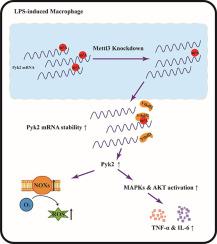Immunology Letters ( IF 4.4 ) Pub Date : 2023-11-10 , DOI: 10.1016/j.imlet.2023.11.004 Yongjie Cai 1 , Ruiqing Yu 1 , Zhanqi Zhang 1 , Di Li 1 , Baicheng Yi 2 , Zhihui Feng 1 , Qiong Xu 1

|
As one of the most prevalent modifications on RNA, N6-methyladenosine (m6A) has been recently found implicated in various pathological processes. Emerging studies have demonstrated the role of m6A and its writer Mettl3 in fine-tuning the immune response, which now becomes a research hotspot owing to its potential therapeutic value. However, the results are inconsistent and even contradictory, suggesting that there might be multiple Mettl3 target genes involved in different pathways. To delve deeper into the function of Mettl3 in the cellular inflammatory response, we first conducted bioinformatics analysis using RNA-seq in Mettl3 ablation macrophages, and found that Mettl3 might attenuate LPS-induced proinflammatory pathways and reactive oxygen species (ROS) generation process. Mettl3 knockdown significantly increased the LPS-induced IL-6, TNF-α, NOXs (Nox1, Nox2, Ncf1, and Ncf2) expression, ROS generation, and the phosphorylation of MAPKs and AKT signaling. Combining the results of RNA-seq and m6A mapping, we found that Pyk2 might be the target gene of Mettl3 affecting the inflammatory response. Mettl3 and Ythdf2 depletion increased the expression and mRNA stability of Pyk2, and RIP-PCR showed that Ythdf2 directly targeting Pyk2 was Mettl3 dependent. Moreover, the upregulated expression of TNF-α, IL-6, NOXs, ROS generation, and the phosphorylation of MAPKs and AKT signaling were downregulated by Pyk2 inhibitor in Mettl3 knockdown cells. All of these results suggest that Mettl3 regulates the mRNA stability and expression of Pyk2 in a Ythdf2-dependent way, which consequently triggers the activation of MAPKs and AKT signaling and upregulation of NOXs, thus promoting the generation of proinflammatory cytokines and ROS.
中文翻译:

Mettl3/Ythdf2 通过控制 Pyk2 mRNA 稳定性来调节巨噬细胞炎症和 ROS 生成
作为 RNA 上最常见的修饰之一,N6-甲基腺苷 (m 6 A) 最近被发现与多种病理过程有关。新兴研究证明了 m 6 A 及其书写者 Mettl3 在微调免疫反应中的作用,由于其潜在的治疗价值,现已成为研究热点。然而,结果不一致甚至矛盾,表明可能存在多个Mettl3靶基因参与不同的通路。为了更深入地研究Mettl3在细胞炎症反应中的功能,我们首先使用RNA-seq对Mettl3消融巨噬细胞进行生物信息学分析,发现Mettl3可能减弱LPS诱导的促炎途径和活性氧(ROS)生成过程。Mettl3 敲除显着增加 LPS 诱导的 IL-6、TNF-α、NOX(Nox1、Nox2、Ncf1 和 Ncf2)表达、ROS 生成以及 MAPK 和 AKT 信号传导的磷酸化。结合RNA-seq和m 6 A作图结果,我们发现Pyk2可能是Mettl3影响炎症反应的靶基因。Mettl3和Ythdf2的缺失增加了Pyk2的表达和mRNA稳定性,RIP-PCR表明直接靶向Pyk2的Ythdf2是Mettl3依赖性的。此外,在 Mettl3 敲低细胞中,Pyk2 抑制剂下调了 TNF-α、IL-6、NOX 的表达、ROS 生成以及 MAPK 和 AKT 信号的磷酸化。所有这些结果表明,Mettl3 以 Ythdf2 依赖性方式调节 Pyk2 mRNA 的稳定性和表达,从而触发 MAPK 和 AKT 信号的激活以及 NOX 的上调,从而促进促炎细胞因子和 ROS 的产生。



























 京公网安备 11010802027423号
京公网安备 11010802027423号